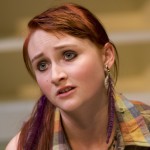 There are several tools that I use to develop every role I play: casting unseen characters, filling in minute details, and creating a character playlist. I applied all of these to the development of Debbie in The Real Thing, but I also discovered a new tool in the process: using design elements for inspiration (particularly sound and costume design in this case).
There are several tools that I use to develop every role I play: casting unseen characters, filling in minute details, and creating a character playlist. I applied all of these to the development of Debbie in The Real Thing, but I also discovered a new tool in the process: using design elements for inspiration (particularly sound and costume design in this case).
I usually begin developing a character by “casting” all of the people who are mentioned in the play but don’t actually make an appearance. In Act 2 Scene 3, my character (Debbie) is making preparations to leave her family and go on the road with a guy she’s supposedly in love with. I wanted to have a clear image in my mind of who this guy was so I picked a real person. Sometimes I choose someone I know personally, but in this case I chose a celebrity: Ryan Gosling. I mean, who wouldn’t run off with Ryan Gosling, even if he were some kind of gypsy? He’s someone who I think would mesmerize even a very intelligent 17-year-old.
Since the play takes place about ten years before I was born, I had to do a little research to familiarize myself with concepts such as free love, and to work on interpreting Stoppard’s language. Then I was able to fill in the more minute details of Debbie’s life like her birthday, address, favorite color, and other things that every person knows about themselves, and therefore every character should too. I go even deeper and start thinking about things like what career she wants to pursue, what her favorite band is, and even whether or not she believes in God. I’m not sure yet whether having these answers enhances my performance, but they reassure me that my character is fully developed, and that I am presenting as whole of a person as I can.
I mentioned earlier that I thought about things like what her favorite band may be. Because my scene takes place in 1983, I looked at some UK music charts from 1980-1983 and discovered a lot of hits such as Duran Duran’s Hungry Like the Wolf, The Jam’s Town Called Malice, and others that I thought Debbie would listen to. That brings me to the point about how other artistic elements of the show actually informed my character, which has never happened to me so substantially before. I think Debbie may be like Henry in the sense that he doesn’t like artists; he likes singles. And perhaps she even shares his affinity for 60’s pop music, and therefore likes many of the songs played throughout the play that I jam out to while performing scene changes: The Zombies’ Time of the Season, Wayne Fontana’s Game of Love, and the Hollies’ Look Through Any Window. These artistic choices definitely informed my character’s music taste, as much as they informed what I listen to on the Metra to Glencoe.
Perhaps the element that affected my character the most was my costume. In addition to the ripped black jeans, checkered vest, and feather earrings, I have also dyed my hair red and painted my nails a solid black. Costume Designer David Hyman’s vision for Debbie really helped me tap into my character’s eccentricity, and also how she wears her ideals on her sleeve. It reinforces Debbie’s modernity especially in contrast to her father, and how cool Debbie is in contrast to me. Honestly, it’s awesome playing a character that is so much cooler than me.


1 Comment
[…] can read it directly from their website (http://blog.writerstheatre.org/?p=474) or just scroll down and read it on […]